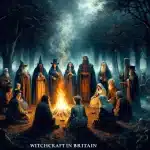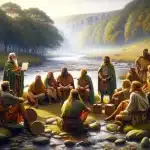Last Updated on 28/01/2024 by Alex Hamlyn
Table of Contents
The Vikings, a formidable force from Scandinavia, brought not only their prowess in warfare to Britain between the 8th and 11th centuries but also their intricate beliefs in witchcraft and magic.
The Viking Age, saw the spread of the Norse culture and its unique practices, including the mystical art of “seiðr,” across the British Isles. The integration of Viking witchcraft into British society, characterised by its roots in Norse mythology and its varied applications from prophecy to healing, marked a significant cultural and spiritual influence that shaped the historical tapestry of Britain during this era.
Viking views on witchcraft, known in Old Norse as “seiðr” (sometimes spelled “seidr”), were complex and deeply rooted in their mythology and cultural beliefs. The Vikings, originating from what is now Denmark, Norway, and Sweden during the Viking Age (approximately 793–1066 AD), had a distinct set of beliefs regarding magic and witchcraft.
Seiðr and Norse Mythology
Seiðr, often spelled as “seidr,” was a form of magic predominantly associated with prophecy and divination in Viking culture. It was deeply intertwined with Norse mythology and was believed to be a practice taught by the gods themselves, particularly by the god Odin and the goddess Freyja. Seiðr practitioners were often seen as seers or wise people with the ability to foresee the future, communicate with spirits, and manipulate fate.
Seiðr was a form of magic primarily associated with prophecy and altering destiny. It was closely linked to Norse mythology. The god Odin and the goddess Freyja were both associated with seiðr. Odin was said to have learned seiðr from Freyja, and it played a significant role in their mythological narratives.
(In the Marvel Cinematic Universe, Freya is the adopted mother of the Jötunn (giant) known as Loki. There is no real familial connection between these characters in Norse mythology, but Marvel’s interpretation shows Loki as having learned magic, particularly magic able to trick or deceive, from his mother.)
Seiðr Magic
The Vikings distinguished between different types of magic. Alongside seiðr, there was “galdr,” which involved the use of runes and incantations, and “lyfja,” which was more akin to herbalism or medicine. Seiðr, however, was considered more controversial and was often associated with ergi (unmanliness or effeminacy), which was a serious slur in Viking society.
Seiðr was often practised by both men and women, though women practitioners, known as vǫlvas (singular: vǫlva), were more socially accepted. These vǫlvas were respected and sometimes feared figures who travelled from town to town performing acts of divination and prophecy. Male practitioners, called seiðmenn, faced social stigma due to the association of seiðr with ergi.
Viking beliefs in witchcraft extended beyond seiðr to include various forms of magic known as “galdr,” which involved the use of spells and incantations, and “trolldom,” which referred to a more general sense of sorcery. These practices were interwoven with the Vikings’ understanding of the world, which was populated by a host of supernatural beings including gods, giants, dwarves, and elves. The interaction with these beings, through rituals, sacrifices, and magic, was a way to navigate and influence the forces of nature and fate.
Viking witchcraft and magic were not solely focused on divination or manipulation of the supernatural. They also had practical applications, such as healing, protection in battle, and ensuring successful voyages. Magic runes, for instance, were often used as talismans for protection or to achieve specific goals.
Norse Magic Runes
Norse runic magic revolves around the use of runes, which are characters from the runic alphabets used by early Germanic peoples, including the Vikings. These alphabets, such as the Elder Futhark, Younger Futhark, and the Anglo-Saxon Futhorc, were not only used for writing but also held significant magical and divinatory properties. Here are some key aspects of Norse runic magic:
Runes as Symbols of Power
Each rune symbolises a specific sound, but beyond that, they also represent various elements, gods, natural forces, or concepts. For instance, the rune ‘Fehu’ represents wealth and prosperity, while ‘Isa’ symbolises ice and stillness.
Runic Inscriptions for Magic
The Norse believed that inscribing runes onto objects could imbue them with magical properties. This could involve carving runes onto weapons for strength in battle, onto amulets for protection, or onto tools for success and efficiency.
Divination and Prophecy: Runes were used in divination practices. The method typically involved casting runes on a cloth and interpreting their positions and relationships to predict future events or seek guidance. This practice was often performed by individuals with specialised knowledge, such as the vǫlvas (seeresses).
Runic Spells and Charms
Runes were combined in specific sequences to create spells and charms for various purposes, such as healing, love, protection, and cursing enemies. The combination of runes and the intent behind their use played a crucial role in their effectiveness.
The discovery and use of runes were often attributed to the god Odin. According to legend, Odin hung himself from the world tree, Yggdrasil, for nine nights, pierced by his own spear, to gain the wisdom of the runes. This myth underscores the runes’ perceived divine origin and power.
Much of what is known about runic magic comes from various Norse literary sources, such as the Eddas and sagas, as well as archaeological findings. These sources often include references to runes and their magical uses.
While the historical accuracy of some of these practices is debated among scholars, runes have continued to capture the modern imagination. They are often used in contemporary Pagan and esoteric practices, though these modern interpretations can differ significantly from their historical counterparts.
Rituals and Ceremonies
Seiðr involved various rituals, which could include chanting, the use of special staves, and trance-like states to interact with the spirit world. The rituals were often conducted for purposes such as divination, healing, affecting weather, or influencing the outcome of events.
While there was a degree of respect for the magical practices and the practitioners, there was also fear and suspicion. This ambivalence is reflected in the sagas and poems where seiðr practitioners could be seen as wise or, alternatively, as manipulative and dangerous.
Christianization and Decline of Seiðr
As Christianity spread through the Viking lands, pagan beliefs, including seiðr, were increasingly demonised and suppressed. Christian texts often portrayed seiðr in a negative light, associating it with devil worship and evil.
Much of what is known about seiðr and Viking beliefs comes from the Icelandic sagas, Eddas, and other mediaeval texts written after the Christianization of the Nordic countries. As these were often written from a Christian perspective, it is extremely likely that they may have influenced the depiction of seiðr and its practitioners. Over time, with the advent of Christianity, these pagan practices and their social acceptance declined significantly.
Read more in this series
Witchcraft in Britain
An Introduction
Witches in Roman Britain
(1st-5th century)
Viking Britain and Witchcraft
(8th-11th century)
Medieval Britain and Witchcraft
(5th century onward)
Plantagenet and High Medieval Britain (12th-15th century)
17th Century: The Peak of Witch Hunts in Britain
Modern Britain And Witchcraft – As Strange As Ever
Witchcraft and the Celts
(Pre – AD43)
Witches in Saxon Britain
(5th-11th century)
Norman Britain and Witchcraft
(11th-12th century)
Early Modern Period and Restoration (15th-18th century)
Victorian Britain and Witchcraft
(19th-20th century)
Famous Witches in British History
(Plus one Witch Hunter)



